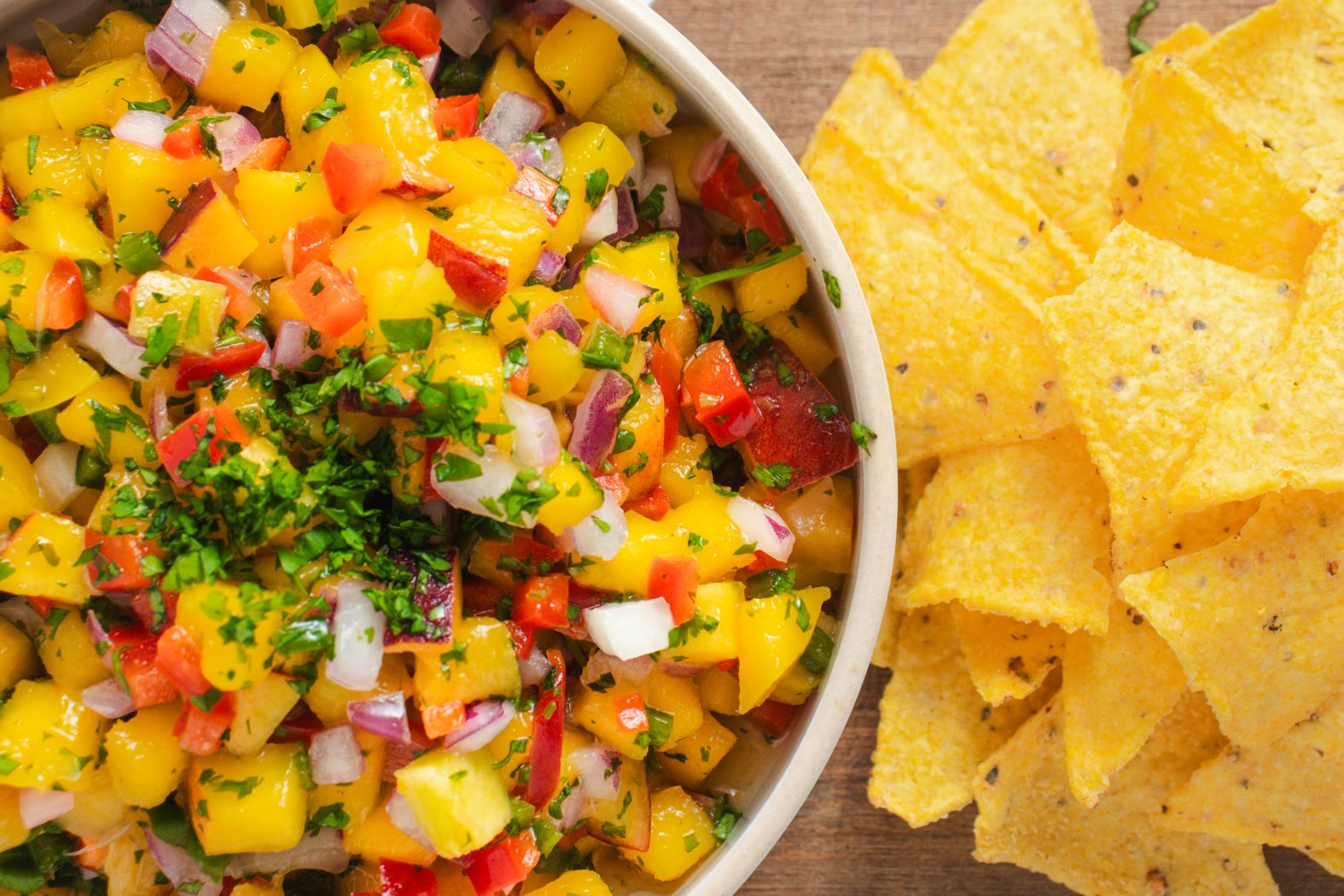
Peach and mango salsa combines the sweetness of ripe fruit with fresh vegetables and zesty lime to create a vibrant appetizer or condiment. This fresh salsa features diced peaches, mangoes, red bell pepper, red onion, jalapeño, and cilantro for a perfect balance of sweet and spicy flavors.
This colorful fruit salsa takes just minutes to prepare and offers a refreshing twist on traditional tomato-based salsas. The recipe works equally well as a dip with tortilla chips or as a topping for grilled chicken, fish, or tacos. The natural sweetness from the fruit pairs beautifully with the heat from jalapeños and the brightness of fresh lime juice.
Home cooks will discover simple techniques for selecting the ripest fruit, proper chopping methods, and creative ways to customize the recipe. Storage tips ensure the salsa maintains its fresh taste and texture when prepared ahead of time.
For more great recipes like this one, try: Roasted Tomato Salsa, Air Fryer Nachos, Best Taco Sauce, and Pollo Asado.
What Is Peach and Mango Salsa?
Peach and mango salsa combines sweet, juicy fruits with traditional salsa ingredients like onions, peppers, and cilantro. This tropical twist creates a versatile condiment that balances sweetness with mild heat and fresh herb flavors.

Peach Salsa vs. Mango Salsa vs. Fruit Salsa
Peach salsa features ripe peaches as the main ingredient, offering natural sweetness and soft texture. The fruit pairs well with red onion, jalapeños, and lime juice.
Mango salsa uses mango as the star ingredient, providing tropical flavor and creamy consistency. This version often includes bell peppers and cilantro for added freshness.
Peach mango salsa combines both fruits in equal portions. This creates a more complex flavor profile than single-fruit versions. The peaches add gentle sweetness while mangoes contribute tropical notes.
Fruit salsa encompasses any salsa recipe that uses fresh fruit as the primary ingredient. Popular varieties include pineapple, strawberry, and apple versions. These recipes follow similar preparation methods but offer different taste experiences.
Each type uses comparable base ingredients like onions, peppers, lime juice, and herbs. The main difference lies in the fruit selection and resulting flavor balance.
Flavor Profile and Texture
Peach mango salsa delivers a sweet-to-spicy flavor range depending on the jalapeño content. The natural fruit sugars create sweetness that balances the heat from peppers.
Key flavor notes include:
- Sweet and juicy from ripe peaches
- Tropical and creamy from mangoes
- Sharp and tangy from lime juice
- Fresh and herbaceous from cilantro
- Mild heat from jalapeños
The texture combines soft, chunky fruit pieces with crisp vegetables. Properly diced ingredients create pleasant contrast between tender fruit and crunchy peppers or onions.
Fresh ingredients maintain the best texture and flavor. The salsa works best when served within hours of preparation, as fruits can become soggy over time.
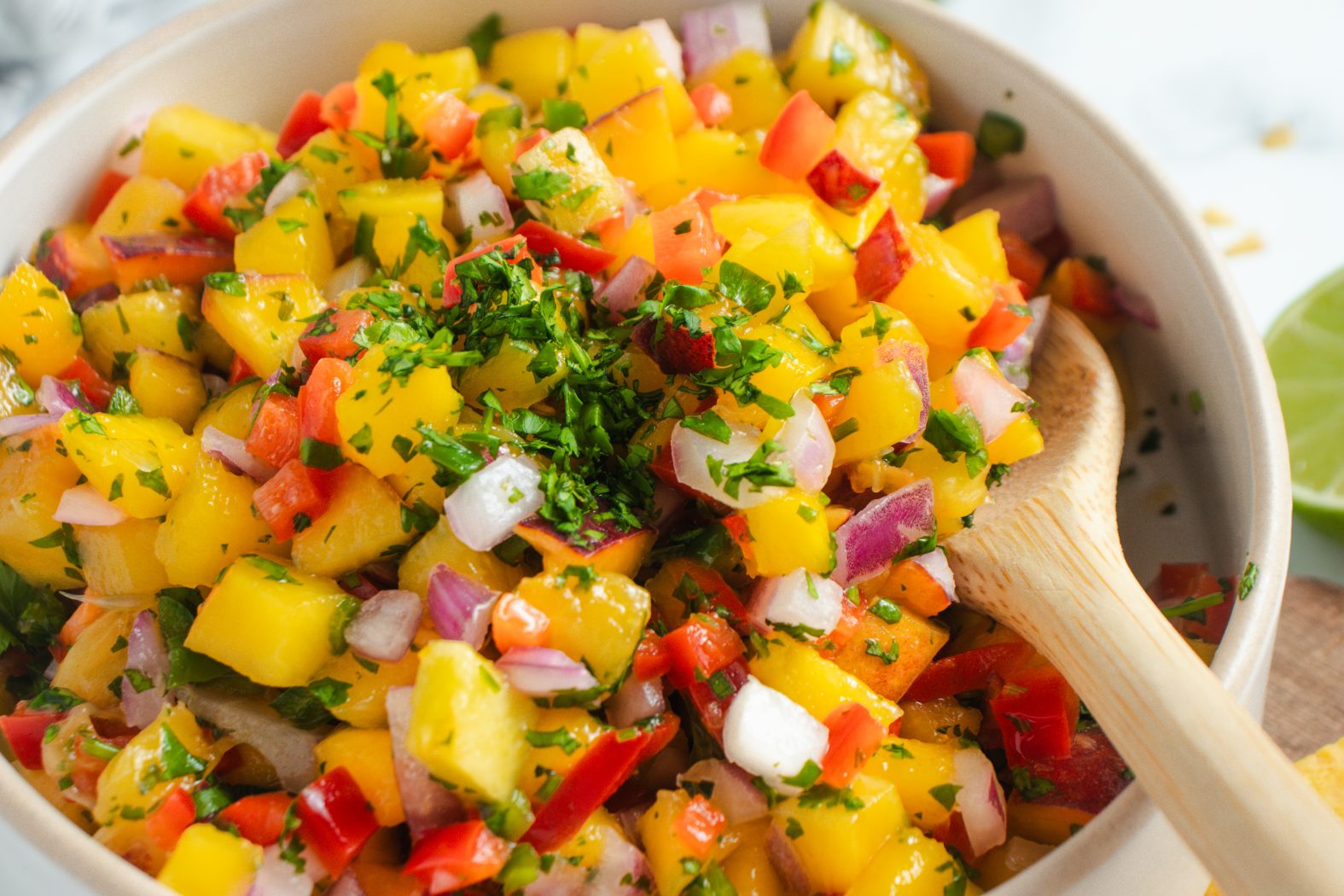
Common Culinary Uses
Peach mango salsa serves multiple purposes in cooking and entertaining. The sweet-spicy combination complements various dishes and occasions.
Popular serving methods:
- Appetizer dip with tortilla chips
- Taco topping for fish or chicken tacos
- Grilled meat accompaniment for pork, chicken, or fish
- Side dish for barbecue meals
The salsa works particularly well with grilled fish and seafood. The fruit flavors enhance mild proteins without overwhelming them.
Many cooks prepare this salsa for summer parties and outdoor gatherings. The colorful appearance and refreshing taste appeal to diverse palates.
The recipe adapts easily to different spice preferences by adjusting jalapeño amounts or adding honey for extra sweetness.
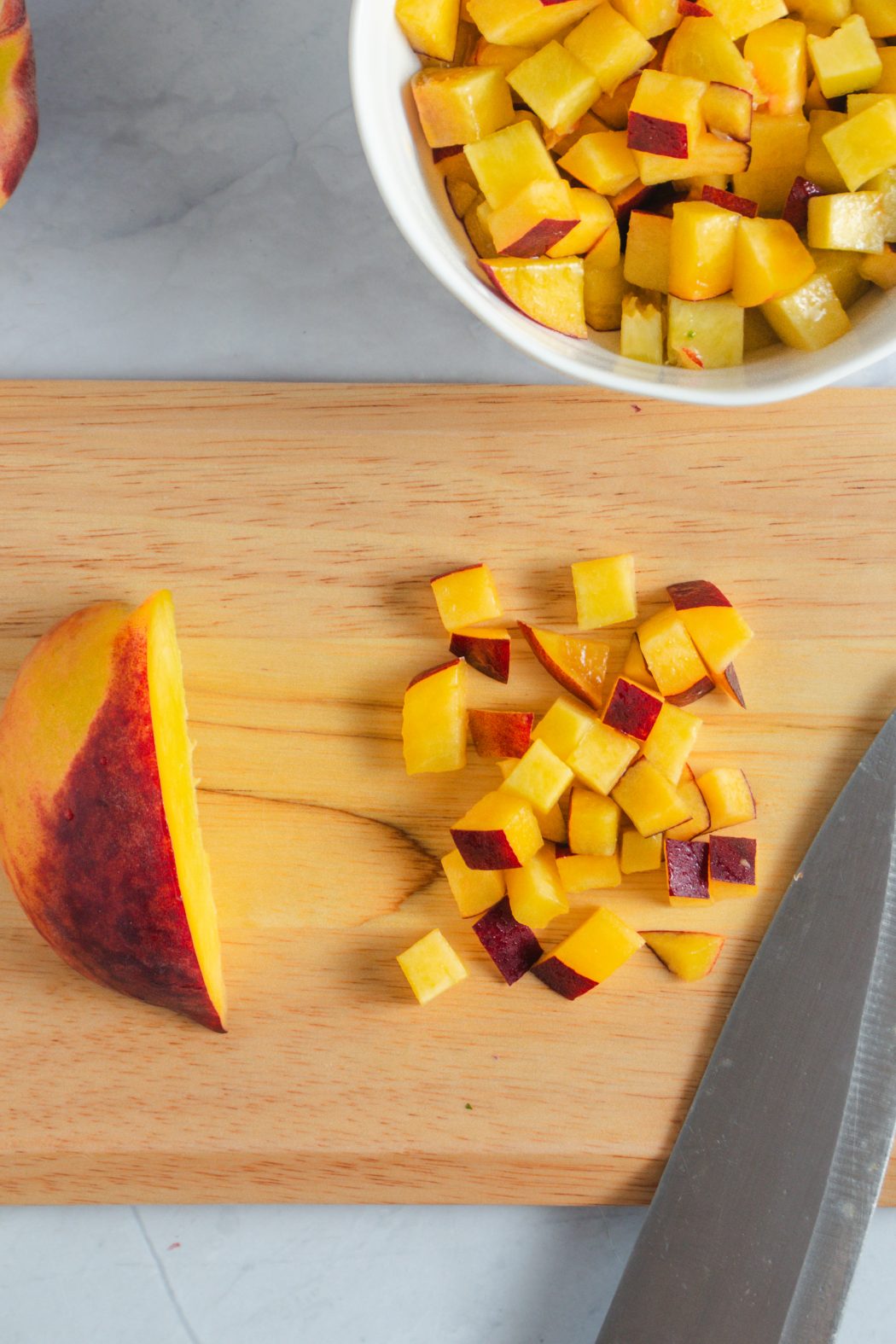
Key Ingredients for Peach and Mango Salsa
Creating the perfect peach and mango salsa depends on choosing ripe fruit and balancing fresh herbs, peppers, and acidic elements. Each ingredient plays a specific role in building layers of sweet, spicy, and tangy flavors.
Selecting the Best Peaches and Mangoes
Fresh peaches should give slightly to gentle pressure and smell sweet at the stem end. Avoid peaches with soft spots or wrinkled skin.
The best varieties for salsa include:
- Yellow peaches: Sweet with balanced acidity
- White peaches: Lower acid content with intense sweetness
- Freestone varieties: Easier to pit and chop
Mangoes are ready when they yield to light pressure near the stem. The skin may show slight wrinkling around the stem area.
Top mango varieties for salsa:
- Tommy Atkins: Firm texture, mild flavor
- Kent: Sweet and juicy with less fiber
- Honey mangoes: Small, very sweet, and creamy
Both fruits should be ripe but still firm enough to dice cleanly. Overripe fruit creates mushy salsa that loses its texture quickly.
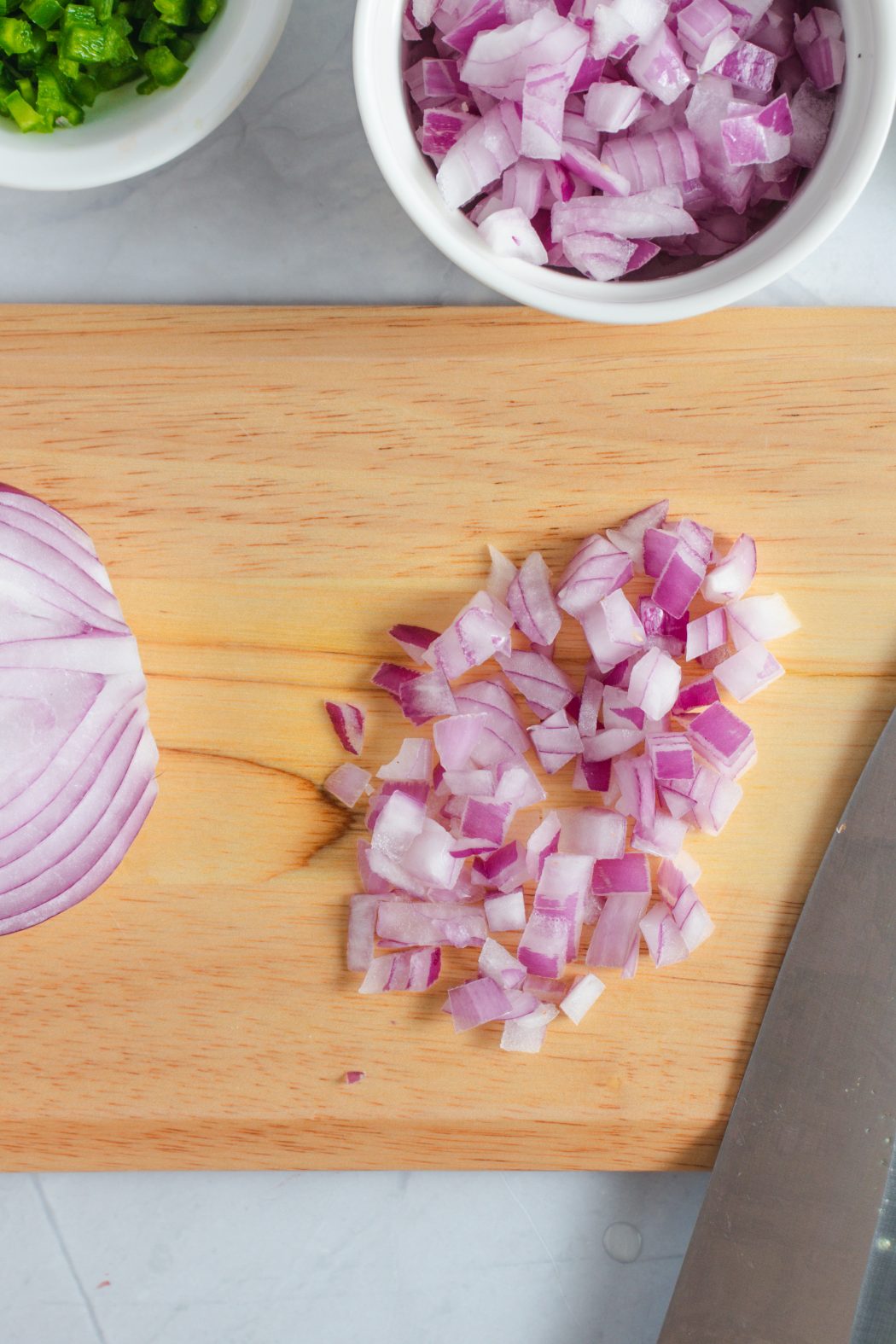
Cilantro, Mint, and Other Fresh Herbs
Fresh cilantro provides the traditional herb base for most salsas. Its bright, citrusy flavor complements the sweet fruit perfectly.
Choose cilantro with bright green leaves and firm stems. Avoid bunches with yellowing or wilted leaves.
Mint adds a cool, refreshing note that pairs well with mango. Use spearmint rather than peppermint for a gentler flavor.
Basil offers an alternative herb option. Thai basil provides slight spice, while sweet basil adds a more subtle flavor.
| Herb | Flavor Profile | Best Used With |
|---|---|---|
| Cilantro | Citrusy, bright | All fruit salsas |
| Mint | Cool, refreshing | Mango-heavy recipes |
| Basil | Sweet, aromatic | Peach-focused salsas |
Use herbs sparingly at first. Their flavors intensify as the salsa sits.
The Role of Jalapeño and Other Peppers
Jalapeño peppers provide the standard heat level for peach mango salsa. Remove seeds and white ribs to reduce spiciness.
One medium jalapeño typically provides enough heat for four cups of salsa. Start with half and add more to taste.
Alternative pepper options:
- Serrano peppers: Hotter than jalapeños with clean heat
- Poblano peppers: Mild heat with earthy flavor
- Red bell pepper: No heat, adds sweetness and crunch
Fresh peppers work better than dried varieties in fruit salsas. The crisp texture and bright flavor complement the soft fruit.
Test pepper heat before adding. Even jalapeños from the same plant can vary in spiciness.
Balancing Sweetness and Acidity
Lime juice provides essential acidity that brightens the fruit flavors and prevents browning. Use fresh lime juice rather than bottled.
One lime typically yields two to three tablespoons of juice. Start with two tablespoons per two cups of fruit.
Honey can enhance natural fruit sweetness when peaches or mangoes lack flavor. Use sparingly to avoid overpowering the fruit.
Red onion adds sharpness that balances the sweet elements. Dice finely and use about one-quarter cup per batch.
Tomatoes, particularly roma varieties, can add body and traditional salsa flavor. They work best when fruit is very sweet and needs balancing.
Salt enhances all flavors and helps draw out fruit juices. Add gradually and taste frequently to avoid over-salting.
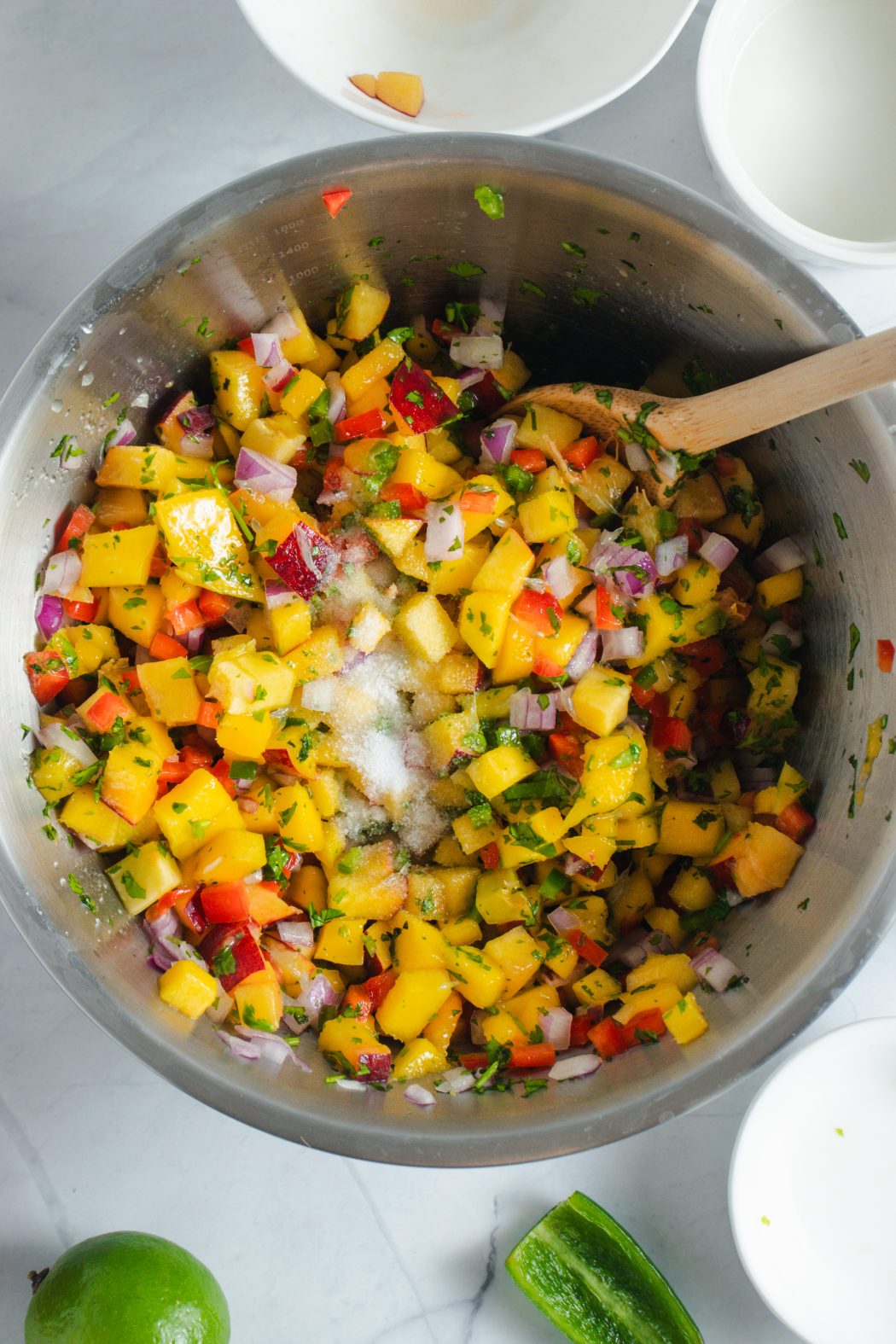
How to Make Peach and Mango Salsa
Making fresh peach mango salsa requires proper knife skills and timing to create the perfect balance of sweet and spicy flavors. The key is using uniform cuts and adjusting seasonings to taste preferences.
Step-by-Step Preparation Guide
Start with 2 ripe yellow peaches and 1 large ripe mango. Remove pits from peaches and peel the mango completely.
Cut both fruits into small, even pieces about 1/4 inch in size. Place the diced fruit in a medium mixing bowl.
Prepare the vegetables:
- Finely chop 1/2 red bell pepper
- Dice 1/4 red onion into small pieces
- Remove seeds from 1 jalapeno and mince finely
- Chop a handful of fresh cilantro leaves
Add all chopped vegetables to the bowl with the fruit. Pour fresh lime juice from 1 lime over the mixture.
Season with salt and pepper to taste. Start with 1/4 teaspoon salt and adjust as needed. Stir everything together gently to combine.
For extra sweetness, add 1 teaspoon honey if desired. Let the salsa sit for at least 1 hour in the refrigerator before serving to allow flavors to blend.
Dicing Techniques for Uniform Salsa
Consistent knife cuts make the biggest difference in salsa texture. All ingredients should be roughly the same size for even distribution.
For mangoes: Cut off both ends and stand upright. Slice down each side of the flat pit. Score the flesh in a crosshatch pattern, then scoop out with a spoon.
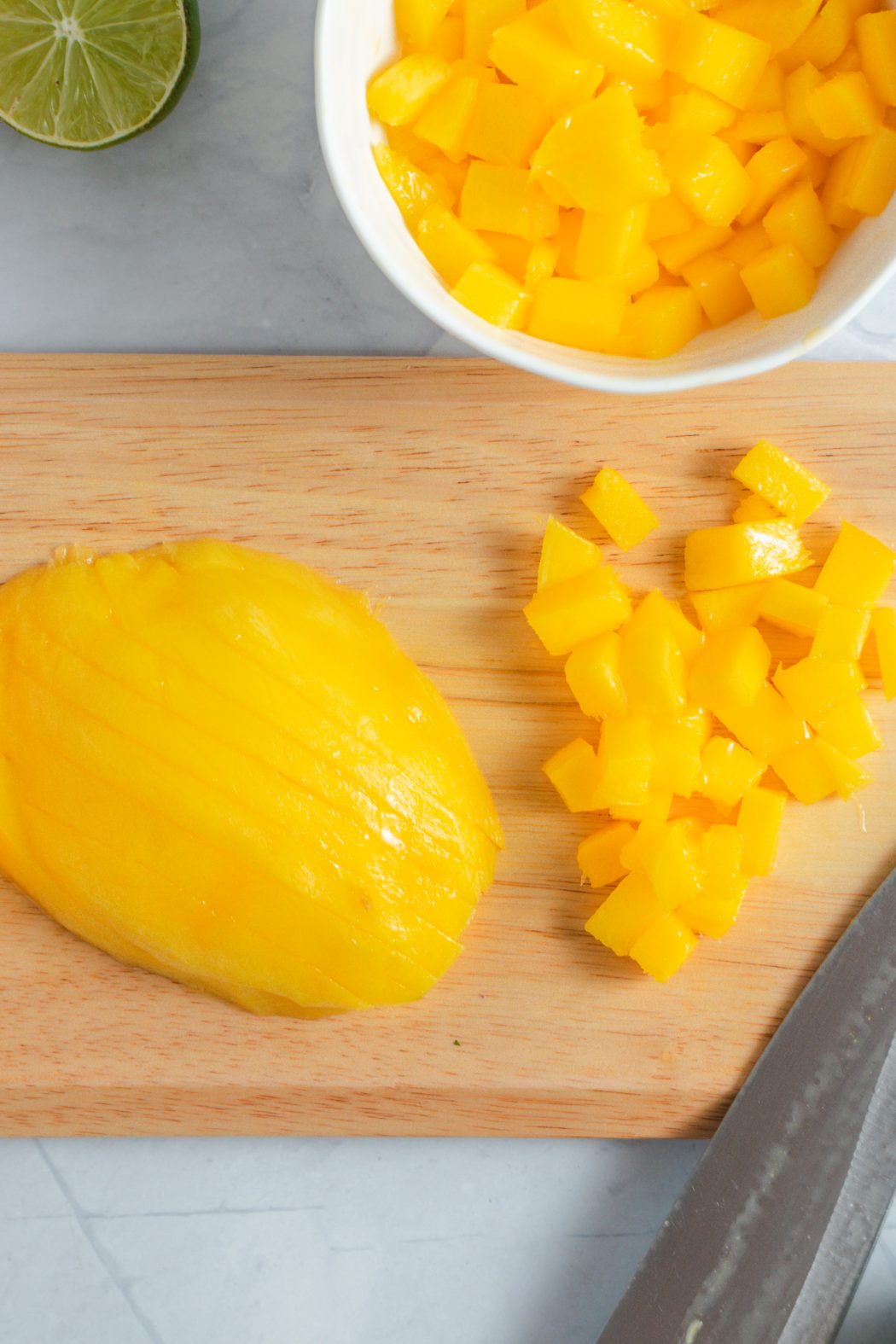
For peaches: Cut around the natural seam and twist to separate halves. Remove the pit and dice into 1/4-inch cubes. Peeling is optional for softer texture.
Keep bell pepper and onion pieces slightly smaller than the fruit. This prevents them from overpowering the sweet flavors.
Use a sharp knife to avoid crushing the soft fruit. Clean cuts help maintain the salsa’s fresh appearance and prevent mushiness.
Tips for Adjusting Spice Level
The jalapeno provides the main heat source in this salsa recipe. Remove all seeds and white membranes for mild heat.
Spice level guide:
- Mild: Use 1/4 seeded jalapeno
- Medium: Use 1/2 seeded jalapeno
- Hot: Include some seeds or add serrano pepper
Taste the salsa after mixing and add more chopped jalapeno gradually. Remember that spice builds over time as the salsa sits.
Red pepper flakes or cayenne powder can boost heat without changing texture. Start with a pinch and mix thoroughly.
For those who want no heat, substitute the jalapeno with extra red bell pepper. The salsa will still have great flavor and crunch.
Serving and Pairing Suggestions
Peach and mango salsa works perfectly as a fresh appetizer with crispy tortilla chips and adds bright tropical flavors when used as a topping for tacos, fajitas, and grilled proteins. The sweet and spicy combination complements both casual snacking and main dishes.
As an Appetizer with Tortilla Chips
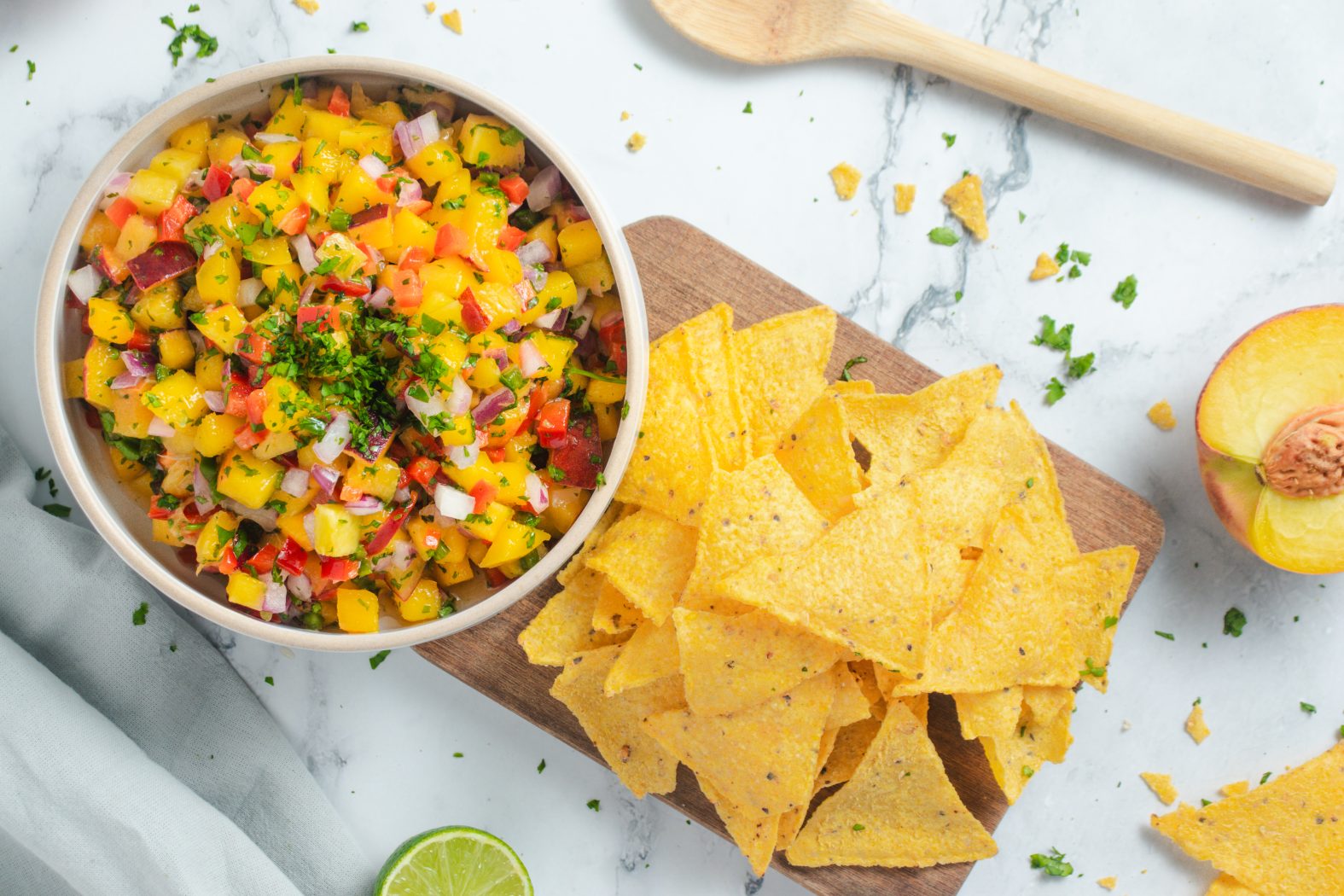
Scoop-style tortilla chips work best for serving peach and mango salsa as an appetizer. The curved shape holds more salsa and prevents dripping.
Best chip options include:
- Thick restaurant-style tortilla chips
- Multigrain tortilla chips
- Baked corn chips
- Homemade air fryer tortilla chips
The salsa should be served chilled for the best taste and texture. Allow it to sit for at least one hour in the refrigerator before serving to let the flavors blend together.
Place the salsa in a medium serving bowl with a spoon for easy scooping. Arrange the tortilla chips around the bowl on a large platter. This appetizer works well for parties, game day gatherings, or casual family snacks.
Topping for Tacos and Fajitas
Peach and mango salsa adds fresh tropical flavors to both fish tacos and shrimp tacos. The sweet fruit balances the seafood’s natural saltiness perfectly.
For fish tacos, use grilled white fish like mahi-mahi or tilapia. Add a small spoonful of the salsa on top of each taco. The combination creates a restaurant-quality meal at home.
Shrimp tacos pair exceptionally well with this salsa. Grill or sauté the shrimp with lime and cumin before adding the fruit salsa on top.
The salsa also works as a fresh topping for chicken or beef fajitas. Serve it alongside traditional toppings like sour cream, cheese, and guacamole. The fruit adds a unique twist to the classic Mexican dish.

Pairing with Grilled Chicken or Seafood
Grilled chicken becomes more flavorful when topped with peach and mango salsa. The fruit’s natural sweetness complements the smoky char from grilling.
Season chicken breasts with salt, pepper, and lime juice before grilling. Cook until the internal temperature reaches 165°F. Let the chicken rest for five minutes, then top with the fresh salsa.
Grilled fish works equally well with this tropical topping. White fish like cod, halibut, or snapper taste best with the fruit salsa. The mild fish flavors don’t compete with the sweet peaches and mangoes.
Preparation tips:
- Grill proteins over medium-high heat
- Add salsa just before serving to maintain freshness
- Serve with lime wedges on the side
Variations and Add-Ins
The classic peach mango salsa recipe can be transformed with simple ingredient swaps and additions. These changes allow cooks to create new flavor profiles while maintaining the fresh, fruity base.
Pineapple Salsa and Other Fruit Combinations
Pineapple salsa creates a tropical twist by replacing half the mango with fresh diced pineapple. This substitution adds more tartness and a slightly firmer texture to the mix.
Other fruit combinations work well too:
- Apple peach salsa: Replace mango with crisp Granny Smith apples for extra crunch
- Papaya addition: Mix in diced papaya for a more exotic flavor
- Berry boost: Add diced strawberries or small blueberries for color variety
- Avocado enhancement: Include cubed avocado for creaminess and richness
The key is using fruits with similar firmness to peaches and mangoes. Soft fruits like bananas don’t hold up well in salsa.
Each fruit brings its own sweetness level. Pineapple adds acidity while papaya stays mild and sweet.
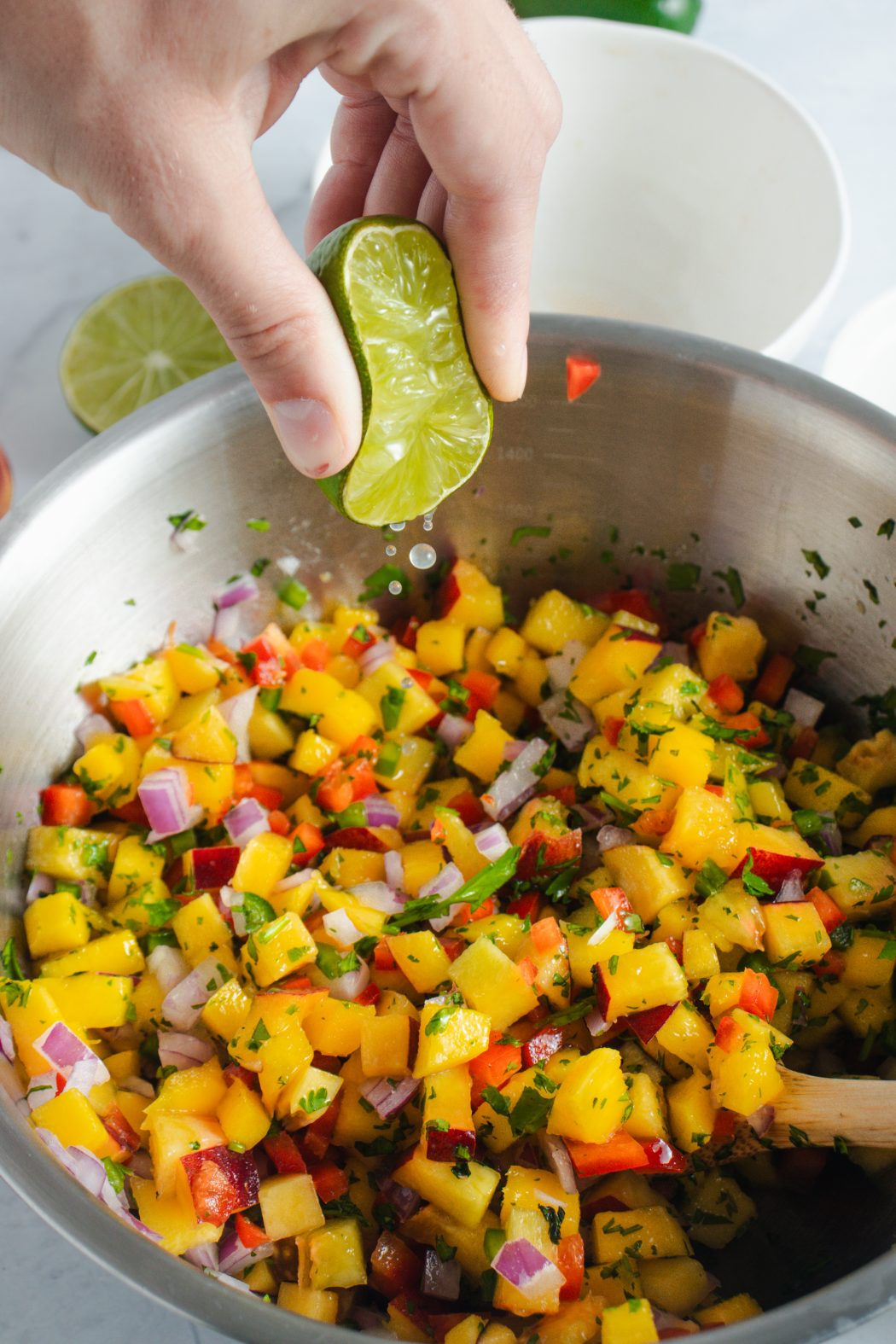
Herb and Pepper Substitutions
Fresh herbs can replace or complement cilantro in many ways. Mint leaves add coolness and pair well with the sweet fruits. Basil creates an Italian-inspired version that works great with grilled chicken.
Parsley offers a milder herb flavor for those who dislike cilantro’s strong taste. Fresh oregano brings an earthy note that balances the fruit’s sweetness.
Bell pepper variations change the salsa’s color and flavor:
| Pepper Type | Flavor Profile | Best Use |
|---|---|---|
| Yellow bell | Sweet, mild | Colorful presentation |
| Orange bell | Sweet, fruity | Tropical dishes |
| Green bell | Crisp, slightly bitter | Traditional taste |
Red onion can be swapped for white onion for sharper flavor or green onions for milder taste.
Making a Spicy Salsa Version
Spicy salsa versions require careful heat management. Start with one seeded jalapeño and add more based on heat preference. Keep seeds in jalapeños for extra spice.
Heat level options include:
- Mild: Remove all seeds, use half a jalapeño
- Medium: Keep some seeds, use one full jalapeño
- Hot: Add serrano peppers or keep all jalapeño seeds
- Very hot: Include minced habanero or cayenne pepper
Other spice additions work well too. Red pepper flakes give heat without changing texture. A dash of hot sauce adds liquid heat and tang.
Fresh ginger brings warmth without traditional pepper heat. Start with just half a teaspoon of minced ginger since it can overpower the fruit flavors quickly.
Storage and Make-Ahead Tips
Proper storage keeps peach mango salsa fresh and flavorful for several days. The key is controlling moisture and maintaining the right temperature to prevent the ingredients from becoming soggy or losing their taste.
Best Practices for Freshness
Store peach mango salsa in an airtight container in the refrigerator immediately after making it. Glass containers work best because they don’t absorb odors or flavors.
Keep ingredients separate until serving when possible. The lime juice and salt draw moisture from the fruit, which can make the salsa watery over time.
Place a paper towel on top of the salsa before sealing the container. This absorbs excess moisture that naturally releases from the fruit.
Add extra lime juice or a pinch of salt before serving leftover salsa. These ingredients help wake up the flavors that may have dulled overnight.
Drain any liquid that collects at the bottom of the container before serving. This prevents the salsa from becoming too watery or mushy.
How Long Does It Last?
Fresh peach mango salsa stays good in the refrigerator for 2 to 3 days maximum. The fruit starts to break down and release too much liquid after this time.
Freezing and Meal Prep Advice
Freezing peach mango salsa is not recommended because the fruit becomes mushy when thawed. The high water content in peaches and mangoes creates ice crystals that damage the cell walls.
For meal prep, chop all ingredients separately and store them in different containers. Combine them on the day of serving for the freshest taste.
Prepare components ahead by dicing the onion, bell pepper, and jalapeño up to 2 days early. Store these in sealed containers in the refrigerator.
Cut the peaches and mango on the same day you plan to serve the salsa. These fruits oxidize and soften quickly once chopped.
Make the cilantro-lime mixture separately by combining chopped cilantro with lime juice and salt. Add this to the fruit mixture just before serving to maintain the best flavor and texture.
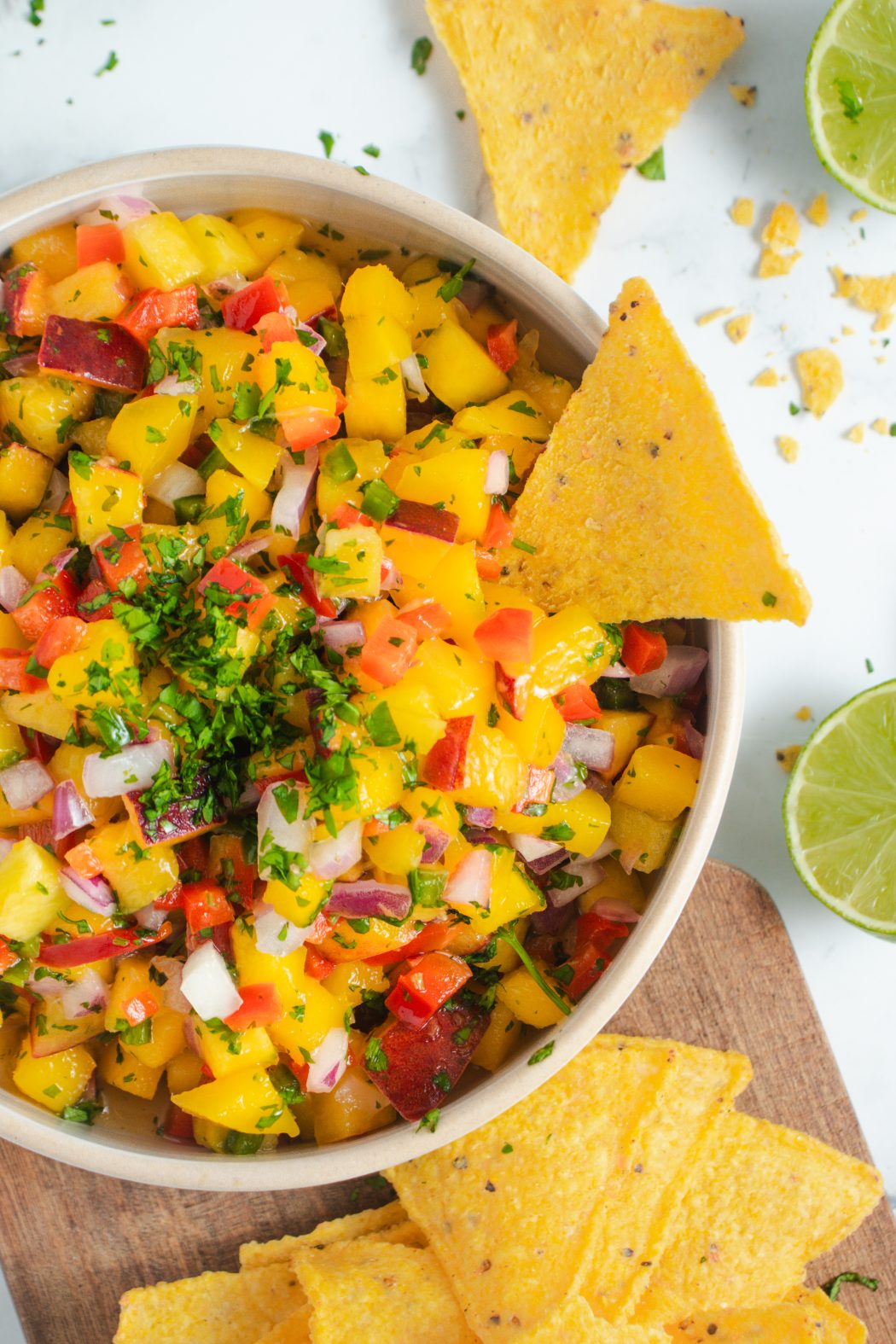
Frequently Asked Questions
These common questions cover basic ingredients, storage methods, simple recipes, and serving suggestions for this sweet and spicy fruit salsa.
What are the essential ingredients for a homemade peach and mango salsa?
The basic ingredients include two ripe yellow peaches and one large mango as the fruit base. Red bell pepper, red onion, and jalapeño provide crunch and heat.
Fresh cilantro and lime juice add brightness to the mixture. Salt balances all the flavors together.
Optional ingredients like honey can enhance the sweetness. Some recipes also include garlic or ginger for extra flavor depth.
What are some dishes that pair well with peach and mango salsa?
Grilled fish and chicken work perfectly with the sweet and spicy flavors. The salsa also complements pork tenderloin and grilled shrimp.
Tacos and quesadillas benefit from the fresh fruit addition. It works as a topping for black bean burgers or veggie wraps.
Tortilla chips remain the classic pairing for serving as an appetizer. The salsa also enhances rice bowls and grain salads.
What are creative ways to incorporate peach and mango salsa into meals?
Spread it on sandwiches or wraps instead of traditional condiments. It works well as a pizza topping with goat cheese or chicken.
Add it to green salads for extra flavor and color. Use it as a sauce for seafood dishes or mix into pasta salads.
Is there a difference between peach mango salsa and Caribbean mango pineapple salsa?
Peach mango salsa focuses on the combination of peaches and mangoes as primary fruits. Caribbean mango pineapple salsa uses pineapple instead of peaches for a more tropical flavor.
The spice levels often differ between the two styles. Caribbean versions typically include more heat from scotch bonnet or habanero peppers.
Ingredient combinations vary with Caribbean salsas often including coconut or tropical herbs. Peach mango salsa tends to use more traditional Mexican salsa ingredients like cilantro and lime.
Peach and Mango Salsa
Ingredients
- 2 peaches yellow, ripe and pitted
- 1 mango large
- 1/2 cup bell pepper red, finely chopped
- 1/4 cup onion red, finely chopped
- 1 jalapeno seeded and finely chopped
- 1 handful cilantro fresh
- 1 TSP salt
Instructions
- Chop mango, peaches, red bell pepper, jalapeno, and red onion into small pieces. Chop cilantro.
- Combine chopped veggies into a medium-size bowl.
- Add lime juice and salt to taste. Stir to mix.
- Optional: add a tsp of honey drizzle.
- Serve immediately with tortilla chips or with grilled fish or chicken.
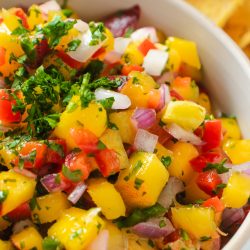
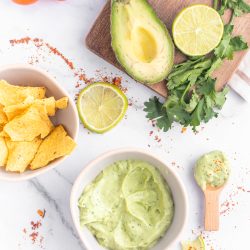
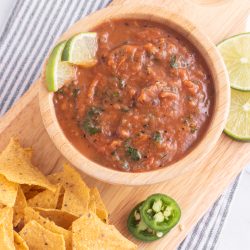

Love the peach and mango combo!